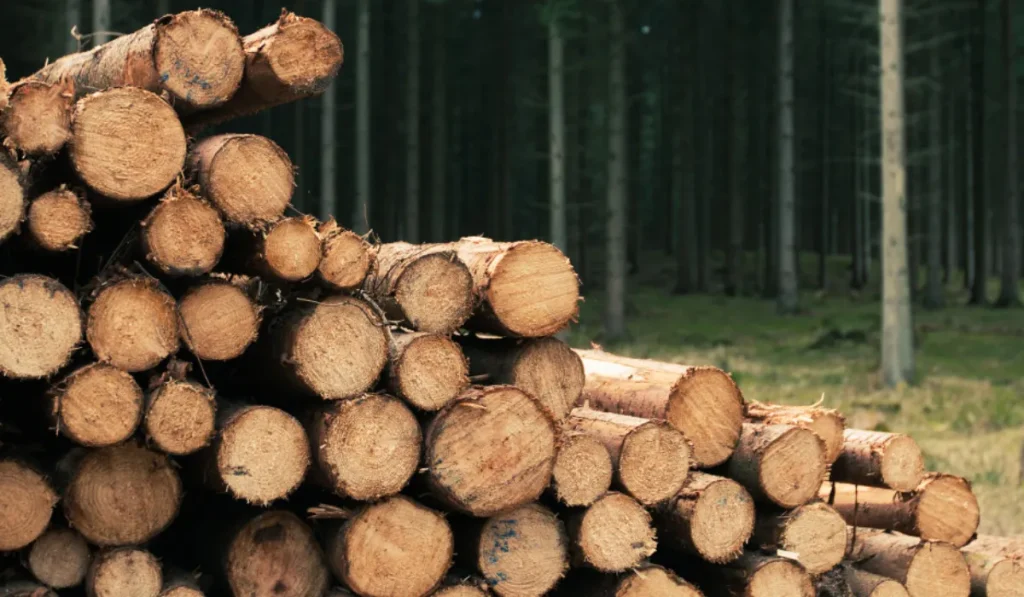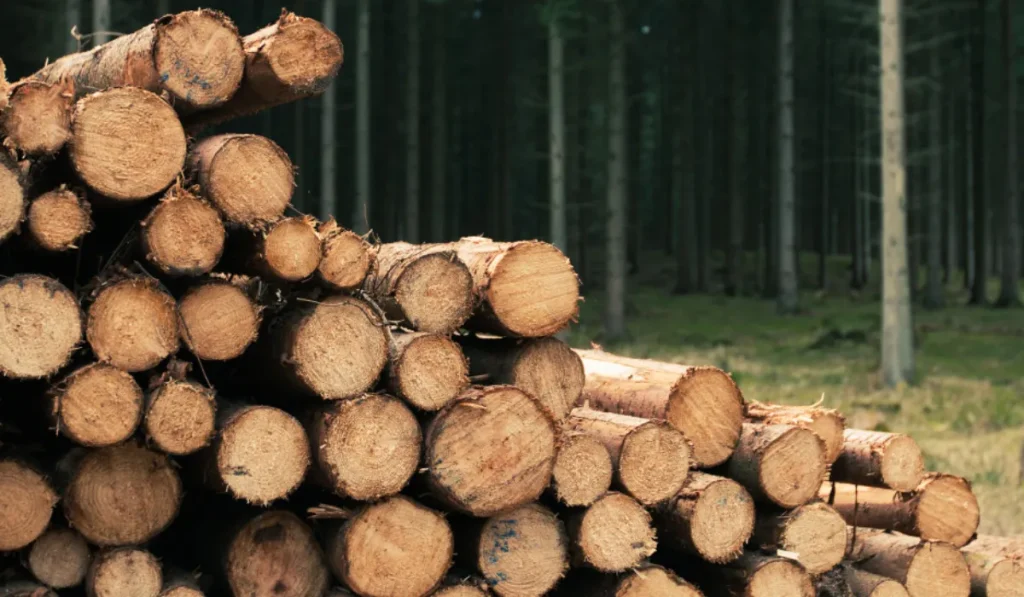The weight of a log can vary greatly, typically ranging from 20 pounds to over 5,000 pounds. It depends on the species, size, and moisture content of the wood.
Understanding how heavy a log is proves crucial in many scenarios, such as construction, logging, and even for those looking to use wood for heating.
Different types of wood have varying densities, which plays a significant role in determining the weight of a log.
For instance, a dense hardwood like oak will weigh more than a softer wood like pine. The moisture content is another essential factor; a freshly cut log, with its high water content, is substantially heavier than a seasoned, dry log.
This information is critical for safe handling and transportation, as well as calculating shipping costs, and ensuring structural support for building projects.
In forestry and lumber industries, knowledge of log weight helps optimize processes and enhance operational efficiency.

The Heft Of Timber
When you look at a piece of timber, it’s hard to guess its weight. Is it really that heavy? The truth is, logs can be quite hefty.
Their weight depends on many things like size, type, and moisture content. Let’s uncover the mystery of how heavy a log can be and what influences its weight.
Factors That Influence Log Weight
Several factors determine how heavy a log is. These include:
- Size: Larger logs weigh more.
- Moisture content: Wet logs are heavier.
- Wood density: Some trees have denser wood.
Density Variations Among Tree Species
Different trees have different wood densities. This means some logs are heavier than others, even if they look the same size. Here’s a table comparing common tree species:
| Tree Species | Density (lbs/ft3) |
|---|---|
| Oak | 45-50 |
| Pine | 25-35 |
| Maple | 40-45 |
| Cedar | 20-30 |
Density affects weight. For example, oak logs are heavier than cedar logs.
Measuring Timber

Understanding a log’s weight is crucial for transport, sale, and milling. Different tools and units help us measure timber accurately.
Let’s dive into the common units of weight and the tools used for measurement.
From Pounds To Tons: Common Units Of Weight
The weight of logs can vary greatly. A small branch might only weigh a few pounds, while a massive log could be tons.
In the lumber industry, professionals often use pounds (lbs) for small quantities and tons for larger quantities.
Knowing these units helps in estimating costs and understanding transportation needs.
- Pounds (lbs): Ideal for small logs and branches.
- Tons: Used for large, heavy logs.
Calipers, Scales, And Volumetric Methods
To measure the weight of logs, different tools and approaches are necessary. For direct measurement, scales are vital.
Calipers help in measuring the diameter, which is useful to estimate volume and weight indirectly. Volumetric methods, including mathematical formulas, calculate weight from volume readings. Accuracy is key in all these methods.
| Tool | Use |
|---|---|
| Calipers | Determining log diameter for volume estimates. |
| Scales | Measuring actual log weight. |
| Volumetric Tools | Calculating log volume for weight estimation. |
Each tool is essential for a full picture of log weight. Calipers and scales ensure precise measurements, which assist in accurate pricing and transport logistics.
Volumetric methods fill in where direct weighing is not feasible. Together, they form the foundation of timber measurement.
Estimating Weight

Estimating Weight: Formulas and Calculations involves considering various factors that affect the mass of wood.
It’s crucial to get accurate readings for tasks like transportation, cost estimation, and project planning.
Role Of Diameter And Length In Weight Estimation
To estimate a log’s weight, we first look at two key dimensions: diameter and length. The thicker and longer the log, the heavier it will be.
Loggers use a formula that combines these measurements. This formula helps them predict the weight without lifting the log. It’s similar to finding the volume, but then adjusted for the log’s specific characteristics:
Weight (lbs) = Volume (cubic feet) x Wood Density (lbs/cubic foot)
Remember, the diameter is not the same across the length of the log. So, it’s often measured at the midpoint for a fair estimate. This midpoint is also called the ‘mid-diameter’.
| Measurement | Procedure |
|---|---|
| Diameter | Measure at the log’s midpoint |
| Length | Measure end to end |
Using Wood Density Charts For Accurate Predictions
Wood density varies by species and affects the overall log weight. Heavier woods like oak have higher density values. Lighter woods like pine have lower numbers.
We use wood density charts for precision. These charts list common woods and their average densities.
With this data, accurate weight predictions are possible after measuring a log’s volume.
- Find your wood species on the chart.
- Read the average density value listed beside it.
- Use the density with the volume to calculate the weight.
Weight (lbs) = Volume (cubic feet) x Average Wood Density (lbs/cubic foot)
To get the volume, one could use formulas like the cylindrical volume calculation or more advanced forestry tools and methods.
Effect Of Moisture Content On Log Weight
The Effect of Moisture Content on Log Weight plays a significant role in the forestry industry. Trees are made up of water and wood fiber.
The more water a log contains, the heavier it is. Understanding how moisture affects log weight is crucial for transport, sale, and processing efficiency.
Green Weight Vs. Dry Weight
Green weight refers to the weight of a log when freshly cut. At this point, the water content is at its peak.
Dry weight, on the other hand, is the weight of the log after it has been dried. Logs can lose up to half their weight as moisture evaporates.
| Weight Type | Description | Moisture Content |
|---|---|---|
| Green Weight | Weight of fresh, unprocessed log | High |
| Dry Weight | Weight after drying out | Low |
Techniques For Measuring Moisture Content
Correctly gauging a log’s moisture content ensures accurate weight assessment. Below are some techniques:
- Oven-Drying Method: The most accurate but time-consuming. It involves weighing a wood sample, drying it in an oven, and then weighing again.
- Electrical Resistance Meters: These meters provide quick estimates by measuring the resistance to an electrical current, which decreases as moisture content increases.
- Microwave Method: Faster than oven-drying but requires caution to prevent overheating, potentially altering the wood’s properties.
Each of these methods offers insight into how much water is present in a log, ultimately impacting its weight.
Practical Implications Of Timber Weight
Understanding how heavy a log is affects many aspects of its use. Especially in the fields of transportation and construction, knowing the weight of timber can guide critical decisions.
Impacts On Transportation And Handling
The weight of timber directly influences how we move and manage it. Here’s how:
- Vehicle Capacity: Heavier logs mean fewer can be transported at once.
- Fuel Consumption: More weight leads to higher fuel use.
Proper equipment is a must for safe handling. For example:
| Log Weight | Required Equipment |
|---|---|
| Light | Manual tools |
| Heavy | Machinery like cranes |
Considerations For Construction And Engineering
In construction, timber weight impacts design decisions:
- Structural Integrity: Buildings need the right support for heavy logs.
- Material Selection: Lighter wood may be better for specific projects.
Engineers must calculate the weight to ensure the safety of structures. They use formulas:
Density (lbs/ft³) x Volume (ft³) = Weight (lbs)
This ensures the right wood supports the load.
Innovations In Wood Science
The world of wood science continually evolves with thrilling innovations. Experts now have new ways to tell how heavy a log is.
These breakthrough methods help us use forests better. They make sure we care for nature while using wood.
Advancements In Weight Estimation Technology
Brilliant minds have created tech that can guess a log’s weight. This tech is smart and fast. It looks at a log and tells us how much it might weigh.
We don’t have to guess or make mistakes anymore!
- 3D scanning tools: They create a model of the log.
- Portable devices: These measure the log anywhere.
- Data-driven software: It uses info to give an accurate weight.
Sustainable Forestry And Weight Management
Keeping forests healthy is key. The new tools help us cut down only what we need. Light logs mean less cutting.
Heavy logs mean more wood with fewer cuts. This helps the forest stay strong and grow. We use the trees well with this smart balance.
| Log Weight | Forest Impact |
|---|---|
| Light Logs | More trees cut |
| Heavy Logs | Fewer trees cut |
FAQs About the Weight of a Log
What Factors Affect A Log’s Weight?
Logs vary in weight due to species, moisture content, and size. Hardwoods typically weigh more than softwoods. A log’s density increases with moisture, making it heavier. Size, including length and diameter, also directly impacts its weight.
How Much Does A Standard Log Weigh?
A standard log, like a pine log of about 8 feet long and 1 foot in diameter, weighs approximately 100-150 pounds. Exact weight varies with species and moisture content, as denser woods and those with higher water content are heavier.
Can Moisture Affect Log Weight Significantly?
Yes, moisture can greatly affect a log’s weight. A fresh, green log can weigh twice as much as its dry counterpart due to water content. As the log dries, it loses moisture and becomes lighter.
Is The Weight Of Logs Important For Shipping?
Log weight is crucial for shipping as it affects transportation costs and vehicle load capacity. Knowing the weight helps ensure compliance with road regulations and safe hauling practices.
Conclusion
Understanding the weight of a log is more than just numbers; it shapes project planning and safety measures.
The variety in tree species and moisture content plays a crucial role. Remember, accurate estimates ensure successful woodworking or construction tasks. Embrace these insights for your next venture into the world of timber.
